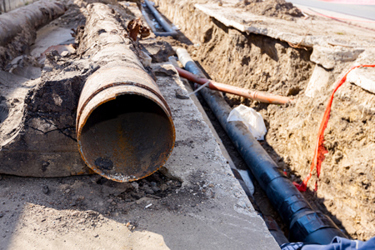Lead And Leaks: The Many Benefits Of Replacing Old Pipes
By Ellie Gabel

Neighborhoods in the U.S. unexpectedly flood from burst pipes, and cities must send unwanted notices to residents about lead traces in the water. These unfortunate circumstances happen often but are easily preventable by replacing old pipes. Utility professionals and engineers must collaborate to upgrade pipe infrastructure to be sturdier and contaminant-free. What are the benefits of these efforts?
Ensuring Public Health And Safety
Fewer employees report workers' compensation claims, and fewer households make unexpected trips to emergency rooms if the water stays clean. Common health ailments include cardiovascular, reproductive, and kidney concerns. Updating old pipes means pollutants are less likely to get into drinking water.
Lead is one of the most prominent concerns of antiquated plumbing infrastructure. Between 2018 and 2020, around 186 million Americans drank water with traces of lead, exceeding the American Academy of Pediatrics recommendations.
There are more unwanted visitors in the water in addition to lead. Bacteria and copper are several examples found in deteriorating piping. As water passes through, these undesirable additions manifest as waterborne illnesses.
It makes residents and businesses distrust utility providers and wastewater treatment facilities. Corporations collaborating to invest in new pipes improve transparency and reputation in all communities.
Improving System Efficiency And Reliability
When pipes contain cracks and leaks, water loss and inefficiencies abound. The U.S. loses around 6 billion gallons of water daily from water main breaks that occur every two minutes. Non-revenue water, which is water lost in the system before it reaches customers, can cause reliability problems and scarcity.
The financial and technical implications impact corporate and customer well-being. Relationships between utilities and treatment facilities diminish because healthy water goes to waste from infrastructure neglect.
Additionally, cracks can exacerbate problems until pipes burst or other issues ensue, leading to service disruptions and irritated customers and clients. Innumerable areas struggle to access clean water stores, so eliminating all waste reinforces relationships and overcomes water poverty.
Replacing old pipes means maintenance workers refine their efforts. They can focus on preventive maintenance instead of reactive repairs when a disaster is already happening. Newer piping also means integrability with smart monitoring systems, catapulting efficiency because minor concerns find quick solutions.
Achieving Environmental Sustainability
Few benefits are more important to fixing pipes than its impact on the planet. Water conservation is critical, primarily when countless communities worldwide have inadequate access. New pipes also salvage more water by reducing the amount that gets unintentionally contaminated beyond treatment methods.
Switching out old lead- and copper-laced pipes also means more sustainable plumbing materials can enter the scene. Numerous options exist, like PVC, clay, and linoleum. Many of these alternatives:
- Have lower carbon footprints.
- Demand less energy to produce.
- Extract fewer resources from habitats.
- Introduce recycled or reclaimed materials.
- Make pipes easier to repair without toxic adhesives.
- Have longer life cycles.
Eco-conscious advantages include integrations with monitoring devices that consume additional electricity. Water companies must use more power to deliver water if inefficiencies create losses. Eliminating leaks decreases uptime and how hard these devices work, potentially saving over 10% of power consumption from equipment.
Boosting Financial Advantages
Installing new equipment is a lifesaver for corporate budgets and household billing statements. Though local economies and private businesses may not love the upfront cost of investing in fresh pipes, the ROI validates the endeavor. Modern pipes last longer and require less upkeep, eliminating countless dollars that can go to other water-based initiatives and R&D.
Sometimes, money comes from outside sources. Funding originates from numerous sources, including investors and federal grants. Source diversity is vital because upgrading and retrofitting critical infrastructure is a project that should involve financial and labor collaboration between regulatory bodies, policymakers, businesses, and citizens. An unforeseen financial advantage of these upgrades is aligning societal priorities and enhancing quality of life.
Property values increase when a region is known for consistent, clean, and abundant water supply, which happens only by transitioning to better pipes. The side effects could empower local communities, make economies flourish, and bring more residents into regions struggling to maintain population growth.
Cleaning Waterways
Citizens and workers alike will appreciate the results of upgraded pipes. The environment gets healthier waterways and soil, people enjoy fewer medical concerns, and economies save money from constant repairs. Infrastructure upgrades benefit households and societies to forge a more resilient population and planet.
Ellie Gabel is a science writer specializing in environmental science and innovative technologies. She can be reached at ellie@revolutionized.com.
